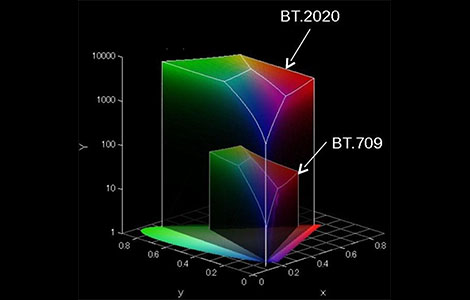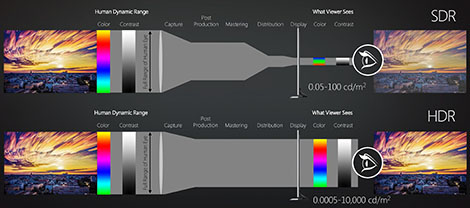High Dynamic Range
True to life images with neo
What is HDR?
HDR is a reflection of how we see the world every day. Our eyes are incredibly sensitive to light, allowing us to see highlight details in the sky while still being able to see in the shadows. And in darker environments we can see detail in virtually no light at all.

SDR
Shadow detail is often lost and brighter sections can appear washed out or white-clipped.

HDR
Shadow detail is distinctive with accurate reproduction, while brighter details appear clearly without any white clipping.
*Images are simulated
More.
That’s what modern TVs promise and deliver. A few years ago, Ultra HD “4K” resolution burst on the scene and brought us more detail than High Definition with 4x the resolution and over 8 million pixels. But detail, resolution, these are only part of what makes for a quality image. HDR fulfills the other half of this next-generation TV promise.
High Dynamic Range improves TV images in two ways. The first is with much brighter highlights. Reflections on a car, a sun setting over the ocean, a flashlight in a dark forest, these can now be noticeably and visibly brighter than the surrounding image. Images with far more pop than before, without the entire image having to be fatiguingly bright. It’s closer to how we see the world. A greater potential contrast ratio, or as the name suggests, a greater dynamic range.


A new level of colour intensity
The other way HDR improves images is colour. Deeper, richer reds, lifelike vibrant greens, indigo blues, and every shade in-between. HDR TVs can create images with a wider array of colours than was possible with HD. This is called Wide Colour Gamut, or WCG, and it allows a possible palette of over a billion colours.
HDR in a TV is the counterpart, in a way, to the HDR mode on a camera, be it a DSLR, point-and-shoot, or on your smartphone. The HDR in a camera takes multiple pictures and combines them to increase the dynamic range of final image. It allows you to capture textures of clouds in a sun-lit sky and the shadows in the forest below. Though the final photo is “SDR”, or standard dynamic range, the details shown wouldn’t have been visible if the camera lacked such a mode. HDR in a TV goes even further. When showing HDR content there’s a wider range of details possible, like those clouds and shadows, but each is shown at a far different physical brightness than was possible before.
Metadata, Bit Depth and more
All this extra performance, however, comes at a cost: bandwidth. HDR adds additional data on top of the already sizeable torrent required for 4K. Older, HDMI® 1.4 connections aren’t capable of HDR at all. Newer HDMI® 2.0 gear usually can, but not always. Long runs between source and display become more challenging. Most video distribution gear won’t be able to handle HDR at all. If someone wants an HDR TV, it’s possible that one single upgrade might also require a new HDR-compatible source, an HDR-compatible extender, an HDR-compatible matrix, perhaps even better HDMI® cables.

Most consumers won’t realize this, of course. They just want their system to work with the latest and greatest. Providing them with the gear they need for a smooth and effortless home theater experience, every time, requires a combination of skill and the right equipment. Right equipment like the neo:Ultra HDMI® Extender, the only HDMI® extender on the market capable of long-distance transmission of 4K HDR video at its highest quality. Or our HDBaseT matrix switchers which can send 4K HDR 24Hz to 4, 8, or even more displays throughout a home.
It’s an exciting time for TVs and TV fans, but with it many technical challenges that smart custom installers will be able to solve.